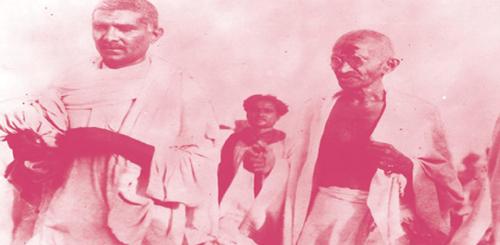Gandhi: The Years That Changed the World, 1914-1948 《甘地改变世界:1914―1948》
2020-03-08多米尼克·格林邓叶
多米尼克·格林 邓叶

There is much to admire about Gandhi, the 20th centurys politician and a perfect subverter1 of power and political logic.
The first volume of Ramachandra Guha2s biography, Gandhi Before India (2013), carried the young Gandhi across the British Empire from Kathiawar to London to Cape Town. In South Africa, Gandhi developed a one-two tactic of Thoreau-style passive resistance3 and Whiggish appeals to the law, and reconciled these secular4 western influences with Hindu precedents as ahimsa5, “non-violence”, and satyagraha6, “truth force”. This volume resumes in July 1914, with Gandhi taking ship from Cape Town for London and then Bombay, and preparing to reconcile India to himself. Like Guhas first volume, it humanises the saint and illuminates the times. Gandhi wanted to replicate his South African success in India by massing Hindus through appeals to tradition, and welding Muslims into this Hindu-majority cause. The stumbling blocks arose within days. A “political and social outsider”, Gandhi relied upon his “guru7” Gopal Gokhale for orientation, and entered Hindu politics as a moderate who defended the caste system while criticising its degradation of the Untouchables8. On his fourth day back in India, Gandhi met Muhammad Ali Jinnah, a Shia lawyer active in the Muslim League.
It is a testament to Gandhis political abilities that by 1920 he was leading the Indian National Congress, and his tactic of mass “non co-operation” had become a human lever for displacing the Raj9 from India. Gandhi had realised in 1908 that British power in Asia was a paper tiger. If the Raj ruled with the consent of the governors, the native kings and princes, it could be overthrown by raising the governed against this alliance. Any other empire would have hanged him. Instead, the British helped him, shamed before their own laws as by the Rowlatt Act10, the slaughter at Amritsar11 and the moral crime of the Salt Tax.
“I realised what a consummate artist-realist the old man must be”, an eye-witness wrote after seeing Gandhi striding forward on the Salt March12 in April 1930. “The breathless walk made you see how urgent and downright and final was his call and message.” Three months after the Salt March, the Labour-led British government invited the Indian factions to negotiate Indias transition to Dominion13 status. Unwilling to compromise on anything less than full independence, he resigned as INC leader in 1934.
Intellectually, Gandhi was a child of late-19th century Lebensreform14. His prose style is George Bernard Shaw15 with the Jaeger suit and bicycle swapped for a dhoti16 and a hand loom. His politics were a spiritual and personal cure, but their translation into communal strategies and geopolitics intensified the ailment. In 1948, he was killed by the religious furies he had invoked.
Guha describes Gandhis sadism towards his children and wife Kasturba; his opposition to contraception; his manipulation of the Muslims and “patronizing” of the Untouchables, and his “na?veté” about non-violence as a tactic against dictators. We also hear about his launching of the Quit India campaign in 1942, when only the British could have stopped the Japanese from turning India into a slave plantation, about which Guha, producing new evidence, suggests that “there may have been, as it were, two sides to the story”.
20世纪的政治家甘地是权力和政治逻辑的彻底颠覆者,他有很多可敬之处。
拉马钱德拉·古哈在传记作品《印度独立前的甘地》(2013)的第一卷描述了年轻的甘地横跨大英帝国殖民统治区,从卡提瓦半岛到伦敦,然后到达开普敦的经历。在南非,甘地发展了一种两面性策略,即一方面如梭罗式的消极抵抗,另一方面又如辉格党人一样诉诸法律,他将西方世俗的影响力与印度教教义中的不杀生、“非暴力”、不合作、“真理的力量”等有机地协调起来。本卷接续上卷,从1914年7月开始讲起:当时甘地乘船从开普敦前往伦敦,然后再到孟买,按照自己的意愿来改造印度。本卷和古哈的第一卷一样,呈现了圣雄的人性光辉,阐述了时代的动荡变迁。甘地想在印度复制他在南非的成功,以传统为口号,将印度教徒团结起来,也让穆斯林融入以印度教徒为主体的事业中。但此时的阻力也与日俱增。由于是“政治和社会的局外人”,甘地遵循自己的宗教导师戈帕尔·戈卡尔引导,以温和派的姿态步入印度政坛。他批判种姓制度,认为这种制度使“不可接触者”地位更低下,同时也维护这种制度。返回印度的第四天,甘地会见了活跃于穆斯林联盟的什叶派律师——穆罕默德·阿里·真纳。
1920年,甘地成为印度国民大会党的领袖,其奉行的大规模不合作政策已成为瓦解英国对印度殖民统治的助推器,证明了甘地的政治才能。早在1908年,甘地就意识到:不列颠帝国在亚洲的统治仅仅只是外强中干。如果英国的殖民统治得到当局统治者、印度国王和王子的认可,那么觉醒的被统治者就会反对这样的联盟,推翻其统治。换成别的帝国政府恐怕都会对甘地处以绞刑,但是英国却协助甘地,他们因《罗拉特法案》、阿姆利则大屠杀和盐税的道德罪行在自己制定的法律面前感到无地自容。
亲睹甘地在1930年4月食盐进军运动中昂首迈进的行为之后,一位见证人写道,“我觉得这位老人一定是个完美的实干家。甘地气喘吁吁地徒步行走让大家看到他的呼吁和要求是多么急切、多么直率、多么决断”。食盐进军运动结束三個月后,由工党所领导的英国政府邀请印度各政治派系商议如何将印度转型至自治领体制。由于甘地不愿在有关印度完全独立的问题上做出任何让步,他于1934年辞去了国大党领袖的职位。
从才智上来看,甘地受19世纪晚期生活改革运动的影响。他朴素的作风可以和乔治·萧伯纳相媲美,只不过甘地总是身系印度腰布,手摇纺织机,而乔治·萧伯纳则喜欢身着棉毛织物,爱好骑单车。另外,甘地的政治观点是精神上的,能给人以治愈,但这些观点衍化成公共策略和地缘政治,加剧了社会的动荡不安。1948年,被甘地激怒的宗教狂热分子杀害了甘地。
古哈在书中描写了甘地对孩子和妻子卡司杜巴的虐行;他反对避孕;操控穆斯林、在“不可接触者”中以恩人自居;用非暴力方式天真地抵抗独裁者。我们也听闻甘地于1942年发起的“英国退出印度”运动,其实当时只有英国能够阻止日本将印度变为其殖民地。古哈对此还提供了新的证据,他认为,“可能如当初一样,这件事有两面性”。
(译者单位:浙江农林大学)
1 subverter颠覆者。 2(1958— ),印度著名历史学家。 3甘地深受梭罗的“论公民的不服从”(Civil Disobedience,另译为“消极反抗”)一文的影响,其思想引导他成为终生消极抵制非正义权势的典范。 4 secular世俗的。 5婆罗门教、佛教等主张的不杀生;非暴力主义。 6(甘地主张的) 非暴力的消极抵抗和不合作主义。
7 guru印度北部锡克教地区最初10名领袖之统称。锡克教徒十分敬重该教的祖师,尊称他们为“古鲁”,即“师尊”。10位师尊之后的领导人不再获此称谓。 8 Un-touchables不可接触者(下等种姓的印度人)。 9专指1947 前英国对印度的殖民统治。
10指英属印度政府于1919年3月通过的一项法案,这项法案在某种程度上是对一战时紧急状态的延续,它授权英属印度政府在未经审判的情况下可以将潜在“恐怖分子”逮捕入狱,而当时英国政府眼里,那些意图争取更多政治权利的革命派们组织的罢工、示威都是恐怖行为。甘地主导的极其隐忍的非暴力抵抗也在其中。 11即阿姆利则惨案,又称为札连瓦拉园屠杀,是指于1919年4月13日发生在印度北部城市阿姆利则的札连瓦拉园、英国人指挥的军队向印度人民开枪的屠杀事件。阿姆利则惨案成为甘地于1920—1922年发动全国性非暴力不合作运动和导致印度最终走向独立的直接原因之一。 12 1930年,印度殖民当局制定了《食盐专营法》,大幅度提高食盐的价格和税收,引起了人民的强烈不满。在这种形势下,甘地毅然领导了“食盐进军”的斗争。1930年3月的一天清晨,甘地带领80名信徒,来到一个修道院宣誓,然后排着整齐的队伍,在炎炎烈日下徒步,开始了“食盐进军”。他们要到遥远的海边去煮盐,迫使殖民当局让步。 13自治领是大英帝国殖民地制度下一个特殊的国家体制,除内政自治外,自治领还有自己的贸易政策和有限的自主外交政策,也拥有自己的军队,但英国政府掌控宣战权。 14指19世纪末20世纪初德国和瑞士的生活改革会运动,宣传回归自然的生活方式,强调健康食品/生鲜食品/有机食品、裸体主义、性解放、替代医学和宗教改革,同时戒除酒精、烟草、药物和疫苗。
15(1856—1950),英国现代杰出的现实主义戏剧作家,世界著名的擅长幽默与讽刺的语言大师,1925年获诺贝尔文学奖。 16 dhoti(印度男子的)多蒂腰布。
